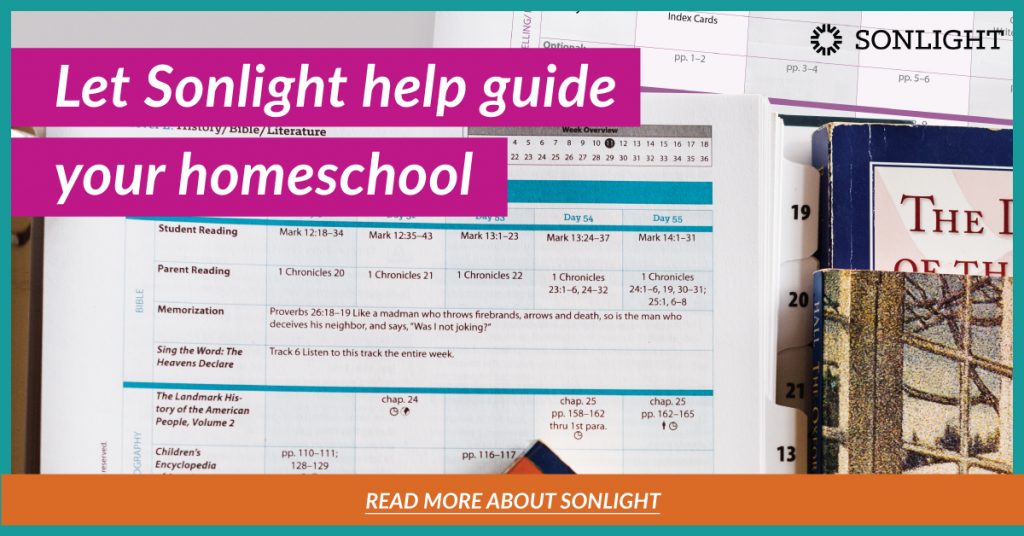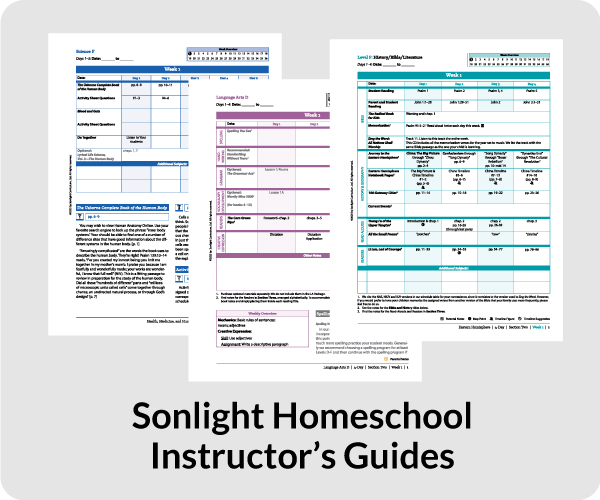When you picture a positive homeschool day, how does it look in your imagination? Are you frantically searching for “the good” pencils, trying to remember which lesson you’re on, and not sure which book to read first? Or are you heading into your homeschool day, confident and ready?

No matter what your natural tendencies, organization can help you cultivate a peaceful, thriving homeschool. These 15 ideas, tips, and tricks have everything you need or create a more orderly approach to learning in your home.
Sonlight Makes Homeschool Organization Easy
The idea of organizing can send many homeschool parents into a whirlwind of worry.
Don’t fret! Organization does not come naturally to everyone, and we can promise that not every other homeschool parent is a “natural organizer.”
The good news is, it does get easier to build systems and routines over time.
In an effort to support you in your homeschool, we asked veteran Sonlight moms for their very best organizational advice.
Below, we break down their top tips and solutions into 3 categories:
- Sonlight organization (content)
- Time organization
- Physical organization (the ‘stuff’ of homeschooling)
We also want to invite you to to hear directly from the moms. They had so much to share, we thought you might want to take a listen.
Everything You Need to Know About Organizing Sonlight Content
First, good news: Sonlight curriculum materials will actually help you feel more organized because they are created to be open-and-go. Our program takes the guesswork out of lesson planning.
Our Instructor’s Guides (IGs) give you a complete plan, but also allow for flexibility because everything is broken down step-by-step. We know what real-life homeschooling is like, so our IGs are designed for busy homeschool parents.
Sonlight Homeschool Instructor’s Guides
We’ve heard homeschool moms call their Sonlight IG their homeschool brain.
A blessing.
A lifeline.
We’ve even heard them joke that Sonlight Instructor’s Guides do everything but make the coffee!
While the IG offers 36 weeks—an entire school year—of daily, no-prep lessons, it can seem overwhelming (and the big blue binder it comes in is heavy).
Our veteran moms have found ways to lessen any intimidation:
Sonlight Mentor Johna Lawrence shares, “I like to pull the schedule pages from the IG into a smaller, ‘working binder.’ In pulling only the sections I was working on into a smaller binder, I could focus on that day and keep us going.”
Adapting Instructor Guides to Your Homeschool Style
While the IG is a key component of your homeschool routine and can help you easily create a daily plan, it is not a rigid taskmaster. You don’t have to do something just because it’s scheduled in your IG, or check every box.
As Jen puts it: “The homeschool police do not come if you skip something in the IG. Use it as you need it!”
If organization comes naturally for you, you can absolutely fill in dates and create detailed notes.
But if your family loves variety, your IG is easy to customize:
- You can simply cross out what you don’t want to do—you’re the boss!
- You can break the IG up into more “manageable” feeling pieces like our mentors mentioned above.
The key is to remember that the guide is there for you, but we’ve made it adaptable, so you can set up your schedule your way.
|
|
Flexing the Sonlight Schedule Without Breaking It
Plenty of Sonlight families homeschool four days a week instead of five, or use loop or block scheduling.
Your Instructor's Guide is designed to be flexible. Learn how with this post on the Sonlight Blog: 10 Ways Your Instructor’s Guide Can Flex for Your Homeschool.
Sonlight Community Manager, Sunny also shares:
“With my first child it was easy to teach Day One as scheduled in the IG. With my second child, I learned to flex the schedule and use it more as a checklist. We often followed the schedule horizontally and read an entire book in one day versus breaking it into daily chapters over the course of the week.”
"Plenty of students (and their parents too) may struggle with “switching gears.” This meant Jen started reading more of one book at a time.
“You know their attention, tolerance … if you can work in fewer books a day, but in larger chunks, there's less transition time between things."
Getting to All the Books
Our Sonlight homeschool veterans agreed, there are a lot of ways to pace Sonlight’s literature-based curriculum.
Johna, for instance, uses a 4-day school year schedule, and adds on extra readers during the summer or saves them for evening reading with the whole family. She may save them for summer breaks when traveling in the car, or choose audiobook versions if she’s driving.
“As soon as I switched my mindset from, ‘I have to do all of these,’ to ‘I get to do these,’ my brain was like ‘ohh—now I can do it. It's easier."
Time Organization and Planning Your Homeschool Days
We’ve discussed ways our homeschool veterans make Sonlight content work for them, but what about balancing multiple children? And what if you also work?
Our experienced Sonlight moms have been there.
Balancing Multiple Learners
Our moms are the first to admit that when you homeschool, finding a way to meet all kids’ needs, and giving age-appropriate help can be a challenge.
One benefit of Sonlight is that we organize our subjects so that many can be taught to multiple ages at once.
Jen shares:
“I have two that are night owls, so getting them up first thing in the morning to do school was never going to be productive. But I had two other kids who wanted to work in the morning. So I started with one of (them), then kind of worked my way, kid to kid to kid to kid.”
Another benefit of Sonlight is that your students often overhear each other’s Read-Alouds, exposing them to even more books.
Can you combine Working and Homeschooling?
Many of our Sonlight families have found ways to combine working and homeschooling their kids, and perhaps Sunny says it best:
“I work 2 1/2 jobs. I have my real job, I have homeschooling, and then I have my mom job all the time. Moms are never off, really. And so yes, I always say I have 2 1/2 jobs.”
So, yes, it is possible to combine work and homeschooling, but again, the key is to stay flexible with instructor guides, scheduling and expectations.
Our veterans also remind us that school doesn’t have to happen just 9 a.m. to 5 p.m., Monday through Friday.
In fact as Jen shared above, sometimes it works best to keep with your kids’ natural early-bird or night-owl rhythms.
“We do school at night on weekdays. That's just something that works better for all of us,” Sunny says. “I was wrapping up school with my 4th grader at 9 p.m. last night. We let our kids sleep in as a result because my husband and I are working during the day.”
Physical Organization In Your Homeschool
Another aspect of homeschooling that can feel daunting is dealing with all the homeschool stuff, like papers, books, and school supplies, especially if you have multiple kids.
That’s just your students’ supplies! As a homeschool parent, you also often have your own paperwork to track.
This is what our homeschool veterans advise:
- Paper Organization
Magazine holders for notebooks, and if possible, color-coding them by child works well in keeping track of paper products in your homeschool. For worksheets, try color-coded bins.
Teach kids to put all their notebooks and papers away at the end of the day, according to their color.
- School and Art Supplies
“My oldest was an artist, and so she had to have the right colored pencils and the right kind of erasers,” Jen says. “We very quickly learned that everybody needed their own pink erasers because I just wasn't willing to do battle about who touched the eraser every day.”
She suggests individual soft-sided pencil cases that can clip into three-ring binders. But for Sunny, one group of school supplies generally works better.
“My artsy creative kid does have his own markers and things that he uses for non-school related things, but school supplies all have to come back to one bucket system that we have,” she says. “We found it was just a little bit easier to keep crayons from spreading all over the house if we kept one bucket for everybody. But you do kind of have to play around with that and see what's gonna work well with your kids.”
- Your Home Library: Organizing Books
Because Sonlight is a literature-based program, there are plenty of books to keep organized. Our veteran moms recommend using clear plastic bins with secure lids.
“They're mouse-proof. They're waterproof. They take up almost no space … you can put them in the corner of a bedroom in just a stack.” —Jen, Sonlight Mom Mentor
Sunny has a different approach:
“I really like the IKEA all the way to the ceiling bookshelves because you can hold so much in those,” she says. “We have from preschool all the way up to level 200 on two of those IKEA bookshelves … so they do hold quite a bit. One of the best things about Sonlight is having that beautiful home library.”
- The School Room
Our Sonlight veterans point out that you really don’t need a “school room,” especially one that looks like a Pinterest photo. Sonlight encourages “table subjects” and couch subjects,” so really, portability is key.
- Homeschool Daily Records and Portfolios
A final organization consideration is how to keep track of important homeschooling documentation and paperwork. Documentation requirements will vary state by state. You can familiarize yourself with what you need here or at hslda.org.
Keeping Portfolios
Some states require homeschooling portfolios—a detailed and organized example of your student’s work. (Check here to see if this is a requirement in your state).
But how long do you have to hold on to your child’s portfolios?
“I always got a letter back that said ‘thank you for turning this in, your responsibility for this home school year has been completed,” Jen says. “I kept that letter. I trashed everything else. If you are one of those moms who it is the joy of your heart to keep every single paper that ever crossed by your child's hand, then please do. Do not let me discourage you, but for the people who are not quite on that level, I throw everything away.”
For even more organizational tips from veteran homeschool moms, check out the video below.
The Key To Successful Homeschool Organization
Keeping your homeschool organized can feel overwhelming, but the moms we spoke with say the key is to take things one step at a time.
“Just trust the process,” says Johna. “Just do the next thing. Don't worry about what's going to happen in three weeks or in two weeks. You just worry about today knowing that when you get done with today, there's going to be tomorrow and you're going to do the next thing and it's going to be OK. I promise you.”

Having an organized homeschool starts with an organized curriculum. See how Sonlight saves you time and keeps your lesson plans on track.








